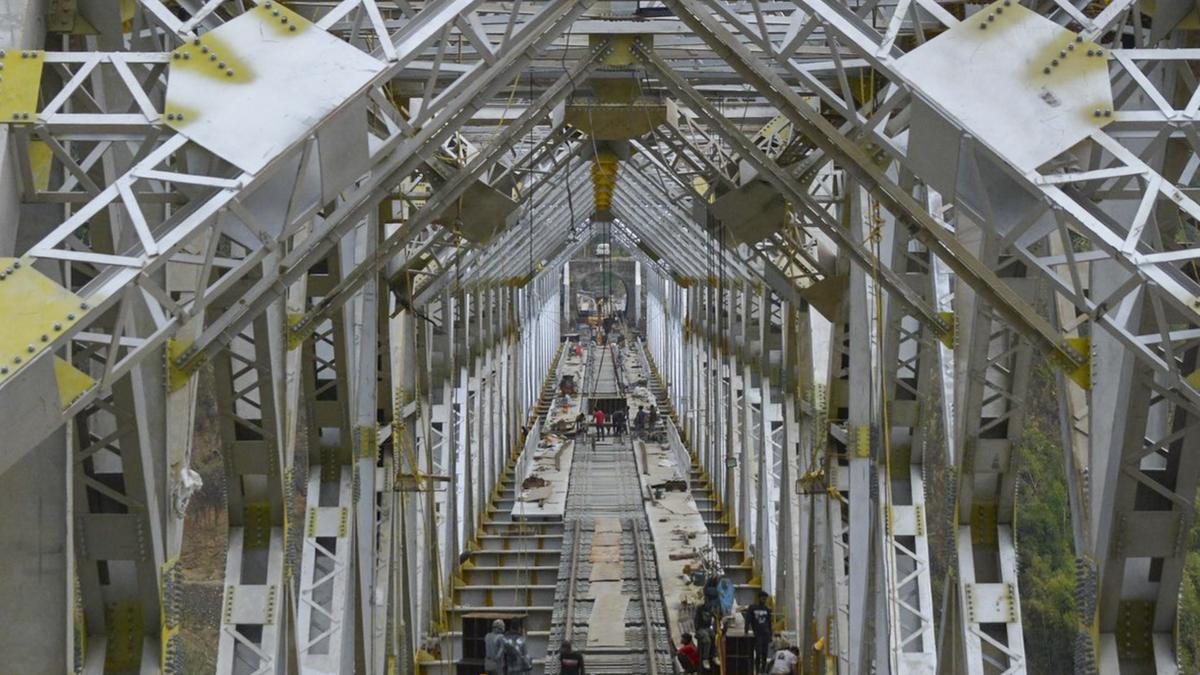The Bairabi-Sairang rail line under construction, in Mizoram.
| Photo Credit: PTI
The story so far: The Indian Railways recently commissioned the new 51.38 km track to Sairang, 18 km short of Mizoram’s capital Aizawl. It raises hopes for India’s ambitious Act East Policy which envisages rail and road links with Southeast Asia.
When did the Mizoram project start?
Mizoram had 1.5 km of metre gauge railway track connecting Bairabi in the State’s Kolasib district to Assam’s Silchar before the gauge conversion project, sanctioned in 2000, was undertaken. The extension of this project to Sairang, which entailed laying a 51.38 km track, began in 2008-09, but the progress was slow due to inclement weather, a difficult and landslide-prone terrain, manpower shortage, and issues with transporting construction materials. The project was part of the Indian Railways’ plan in the early 2010s to connect all the northeastern State capitals to the country’s rail network, although the Sairang railway station is 18 km short of Mizoram’s capital, Aizawl. The Bairabi-Sairang section, which received safety clearance in June 2025 and awaits formal inauguration, has 48 tunnels with a total length of 12.85 km and 142 bridges. The project cost more than ₹5,020 crore and the lives of 18 workers when the bridge with the tallest pier collapsed during construction in August 2023.
What is its significance?
Landlocked Mizoram’s fastest access to the rest of the country is through air travel. The Aizawl-Silchar highway, also via Sairang, is the second-fastest option that consumes at least five hours. Trains, including a proposed Rajdhani Express, from the Sairang railhead will slash this travel time to 1.5 hours and the cost of transportation considerably. Railway officials say the biggest gain for the State will be in tourism, trade, and transportation of goods, reducing the dependence on trucks to a large extent. They said the Sairang railhead is strategic vis-a-vis the Act East Policy, envisaging rail and road connectivity to improve trade with the Association of Southeast Asian Nations (ASEAN) and other East Asian countries, deepen diplomatic engagements, and build stronger security cooperation. Sairang is also expected to be vital for transhipment of goods from the India-funded Sittwe Port in Myanmar.
What is the Act East Policy?
The Act East Policy, announced by Prime Minister Narendra Modi in 2014, was a more ambitious version of the Look East Policy initiated during the Congress government in 1991 with the key objective of transforming the northeastern region into India’s gateway to the ASEAN bloc. Official data show that the Centre increased the budgetary allocations for the region by 300% from ₹36,108 crore during the 2014-15 fiscal to more than ₹1,00,000 crore during 2024-25. More than 10,000 km of highways and 800 km of railway tracks were built, eight new airports established, and several inland waterway projects undertaken during this period. Vital to linking Southeast Asia by rail are the 82.5 km Dimapur-Zubza (near Kohima) project in Nagaland, the Imphal-Moreh plan in Manipur, and the Asian Highway 1 from Assam to Moreh via Kohima and Imphal. While the Nagaland project is on track, the ethnic conflict in Manipur has affected the proposed railway line between Imphal and Moreh.
The connectivity projects to link the northeast with Southeast Asia have not progressed beyond India’s borders due to the unrest in India’s neighbourhood. The Act East Policy ran into the civil war in Myanmar following a military coup in February 2021, followed by the fall of the Sheikh Hasina government in Bangladesh in August 2024. The Agartala-Akhaura railway project, which would have provided Tripura faster access to Kolkata through Bangladesh and connectivity to the Chittagong Port, has been stalled. The biggest setback has been the delay of the ₹2,904 crore Kaladan Multi-Modal Transit Transport Project in Myanmar, which would have reduced the distance between Mizoram and Kolkata by 1,000 km.
Published – August 04, 2025 08:30 am IST

